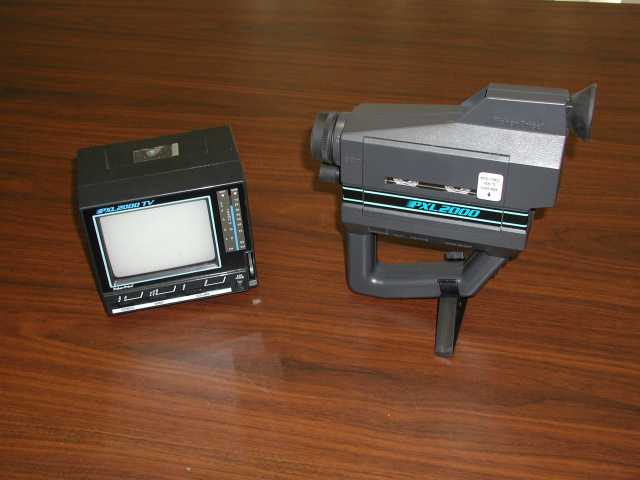LabGuy's World: Fisher Price PXL-2000 B/W Camcorder


Fisher Price PXL-2000 B/W Camcorder & Monitor Vintage: mid 1980s. This is an extremely unique system! The Fisher Price model PXL-2000. It uses a 90 minute length, high bias, audio tape cassette! The tape is running at about 30 to 40 IPS (inches per second), giving a recording time of only about 10 minutes on a cassette! This unit is fully functional and represents the ONLY longitudinal video recorder in LabGuy's whole collection! This beauty is B/W only with a ghostly 15 frame per second video rate. Somehow, the frame rate is synthetically increased to standard 30 frames inside the unit. It has RF output so it will play back on any TV set or on the very cute and tiny 4" B/W TV monitor! These are highly collectable! The resale value is extremely high on these as well. When introduced, in 1985, the camcorder (only) sold for only $99 US. Now, if you can find one for under $300, you should grab it, working or not! There are many web sites devoted to the continuing use of these cameras by artists and other sites that include conversion instructions for adding direct video and audio output connectors for use with standard VTRs. Some sites even offer repair / conversion services for pay. I recently received the following information from Michele Denber:The PXL-2000 (also known as Fisher-Price PXL2000, Fisher-Price PixelVision, Sanwa Sanpix1000, KiddieCorder, and Georgia[ ) was a toy black-and-white camcorder produced in 1987 that uses a compact audio cassette as its recording medium. The PXL-2000 was created by a team of inventors led by James Wickstead, who sold the rights to Fisher Price in 1987 at the American International Toy Fair in Manhattan. When the PXL-2000 was available in retail outlets, it came in two versions, one with just the camera and necessary accessories (power supply, blank tape, etc.), and another which came packaged with a portable black and white television that had a 4.5-inch (110 mm) diagonal screen for use as a monitor. There were also extra accessories sold separately, such as a carrying case. The market success of the PXL-2000 was ultimately quite low with its targeted demographic, in part due to its pricing. Initially sold for $179 (and later reduced to $100), the PXL-2000 was expensive for a child's toy, yet found lasting minor success with a smaller pool of young video artists as a cheap alternative to more expensive handheld videocameras. Only surviving on the market for about a year, only around 400,000 units were ever produced, resulting in the PXL-2000's eventual present status as a sought after cult object among many artists and media historians. The PXL-2000 consists of a simple aspherical lens, an infrared filter, a CCD image sensor, a custom ASIC (the Sanyo LA 7306M), and an audio cassette mechanism. This is mounted in a plastic housing with a bay for consumable batteries and a simple RF video modulator selectable to either North American television channel 3 or 4. A plastic viewfinder and some control buttons complete the device. An ordinary cassette audio tape is used for storage of both audio and video. The PXL-2000 holds 11 minutes of footage by moving the tape at a high speed, roughly 16 7/8 in/s (429 mm/s) as opposed to cassette's standard speed of 1 7/8 in/s (48 mm/s) on a C90 CrO2 (chromium dioxide) cassette. The high speed is necessary because video requires a wider bandwidth than standard audio recording (In magnetic tape recording, the faster the tape speed, the more bandwidth can be recorded on the tape). The PXL-2000 records the video information on the left audio channel of the cassette, and the audio on the right.[4] In order to reduce the amount of information recorded to fit within the narrow bandwidth of the sped-up audio cassette, it uses an ASIC to generate slower video timings than conventional TVs use. It scans the 120 by 90 pixel CCD fifteen times a second, feeding the results through a filtering circuit, and then to a frequency modulation circuit driving the left channel of the cassette head as well as to an ADC, which created the final image for viewing. For playback and view-through purposes, circuitry is included that takes image data from either the cassette or the CCD and uses it to fill half of a digital frame store at the PXL reduced rate, while scanning other half of the frame store at normal NTSC rates. Since each half of the frame store includes only 10800 pixels in its 120 by 90 array, the same as the CCD, the display resolution was deemed to be marginal, and black borders were added around the picture, squashing the framestore image content into the middle of the frame, preserving pixels which would otherwise be lost in overscan. An anti-aliasing low-pass filter is included in the final video output circuit." There's no attribution for this information but also no copyright. [HOME] [VIDEO RECORDERS MUSEUM] Created before: January 09, 2005 Last updated: December 04, 2013 |